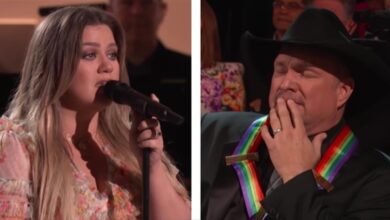Vince Gill Penned This Song After Losing His Brother, But It Was Kelly’s Cover That Moved Me To Tears
Kelly Clarkson’s interpretation of “Go Rest High on That Mountain” transcends the boundaries of a standard cover; it serves as a deep, heartfelt tribute that resonates profoundly with listeners across a wide spectrum of experiences. Originally written and performed by Vince Gill, the song is a poignant farewell that emerged from his personal loss of a brother. Since its inception in 1995, it has provided solace to countless individuals navigating their grief. Clarkson’s rendition, therefore, is not merely an artistic endeavor; it is an emotional homage that embraces the narrative of loss, hope, and healing.
Clarkson, who rose to fame as the inaugural champion of “American Idol,” has established herself as a powerhouse in the music industry, celebrated for her remarkable vocal abilities and emotional delivery. Her career spans various genres—predominantly pop and country—each of which has informed her musical sensibilities. This eclectic background is integral to her interpretation of “Go Rest High on That Mountain.” It allows her to traverse the intricate emotional depths of the song with a nuance that speaks to her own life experiences, lending authenticity to her performance.
From the outset, Clarkson’s version of the song captivates with its gentle guitar introduction, establishing a contemplative atmosphere that encourages the audience to engage in introspection. As she begins to sing, her voice possesses a sincerity that feels intensely personal. Through her delivery, she honors not just the memory of those lost but also acknowledges the shared human experience of grief, creating a powerful connection with listeners. This approach transforms the song into a communal expression of mourning, broadening its emotional reach.
The transition into the chorus showcases Clarkson’s impressive vocal range and emotional breadth. With each note, she skillfully navigates from soft, vulnerable tones to dramatic, soaring crescendos. This contrast embodies the duality of loss and hope, illustrating how these emotions can coexist and fostering a deeper resonance with the audience. It is in this interplay between tenderness and strength that her performance becomes truly compelling, evoking both tears and uplifting sentiments within the same breath.
The arrangement of the song also plays a crucial role in enhancing its emotional weight. Complementing Clarkson’s soaring vocals, the backgrounds of additional musicians create a rich tapestry of sound. The subtle orchestration of strings and harmonies adds a depth that enhances the overall impact without overshadowing her voice. This careful balance ensures that Clarkson remains the focal point, allowing her heartfelt delivery to shine through the lush musical backdrop.
Clarkson’s physical presence during her performance is as impactful as her vocal execution. Her expressions and body language connect seamlessly with the lyrical content, reflecting the heartache and longing inherent in the song. As she leans into the music, her genuine emotional engagement captivates the audience, inviting them into her world of sorrow and healing. This authenticity underscores the profound connection that exists between the performer and the audience, intensifying the shared experience of mourning.
As the final notes of “Go Rest High on That Mountain” fade, a profound silence envelops the space, charged with admiration and reflection. The audience’s applause is not merely a recognition of Clarkson’s vocal talent; it signifies a shared experience of grief and healing that she has so artfully articulated. It is a moment of collective catharsis, illustrating the power of music to heal and unite individuals through their common experiences.
Kelly Clarkson’s performance also embodies the broader healing capabilities inherent in music. For many, songs like “Go Rest High on That Mountain” transcend entertainment; they serve as lifelines during challenging times. Clarkson’s version provides a comforting embrace, guiding listeners through their own journeys of grief and offering a sense of solidarity in their experiences. In this way, she becomes not just a singer, but a vessel for emotional expression and healing.
Furthermore, Clarkson’s influence extends well beyond this particular performance. Her continued presence in the music landscape exemplifies her impact as an artist who consistently resonates with diverse audiences through her authentic representation of complex emotions. With multiple successful albums and numerous chart-topping hits to her name, Clarkson illustrates a career marked by versatility and resilience, continually evolving while maintaining her artistic integrity.
Ultimately, her cover of Vince Gill’s poignant track encapsulates the universal language of music, demonstrating its ability to resonate through experiences of both joy and sorrow. Clarkson’s depth and authenticity breathe new life into the original song, revitalizing its message for contemporary audiences while inviting younger generations to discover its lasting beauty. Through her artistry, she fosters a connection that transcends time, spelling out the intimate dance between grief, remembrance, and hope.





